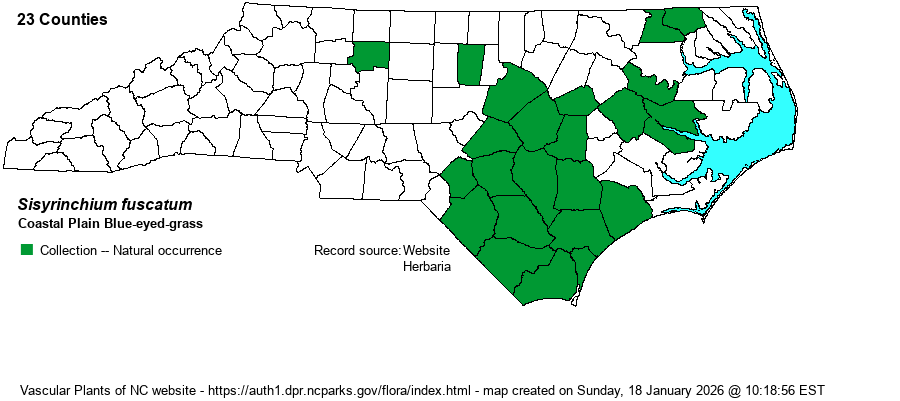| Section 5 » Order Liliales » Family Iridaceae |
Show/Hide Synonym
| taxonName | relationship | relatedTaxonName | relatedTaxonRefText | relComments |
|---|
|
|
|
|
|
| Sisyrinchium fuscatum | < | Sisyrinchium fuscatum | Gleason and Cronquist (1991) | | | Sisyrinchium fuscatum | < | Sisyrinchium fuscatum | Flora of North America (1993b, 1997, 2000, 2002a, 2002b, 2003a, 2004b, 2005, 2006a, 2006b, 2006c, 2007a, 2009, 2010) | | | Sisyrinchium fuscatum | < | Sisyrinchium fuscatum | Kartesz (1999) | | | Sisyrinchium fuscatum | > | Sisyrinchium fuscatum | Small (1933, 1938) | | | Sisyrinchium fuscatum | > | Sisyrinchium incrustatum | Small (1933, 1938) | | | Sisyrinchium fuscatum | < | Sisyrinchium nashii | Wunderlin & Hansen Flora of Florida (3) | | | Source: Weakley's Flora |
|
| Author | Bicknell | |
| Distribution | Found in most of the southern and central portions of the Coastal Plain, but excluding the western Sandhills region; ranges barely into the Piedmont. However, it is known east only to Gates, Wilson, and Onslow counties and thus appears to be absent in much of the eastern part of the Coastal Plain.
This is a mainly Coastal Plain species, but with a moderately wide range. It occurs from MA (if S. arenicola is included) on the north to western FL and barely to LA. It does occur well inland in Atlantic and Gulf Coast states, but apparently absent from TN, KY, and WV. | |
| Abundance | Uncommon to fairly common from perhaps Robeson and Harnett counties south and east to Pender and Brunswick counties; however, absent or nearly so from the Sandhills region, being "replaced" there by S. rufipes. Very rare to rare in the northern Coastal Plain and Piedmont. | |
| Habitat | This blue-eyed-grass occurs in drier and sandier habitats than all others in the state except some S. rufipes. It grows on sand barrens, sandy rims of Carolina bays, and other sandy pine woods and openings. However, it rarely can occur in flatwoods and drier parts of savannas. | |
| Phenology | Blooms from late April to June, and fruits from June into August. | |
| Identification | This species has a light green appearance -- leaves and stem -- and the flowering stem grows to about 1 foot tall, with the leaves somewhat shorter. The stem has somewhat narrow but observable wings, such that it is 2-3 mm across and scabrous (rough to the touch). The species has a dense cluster of brown to reddish brown, fibrous remains of previous years' leaves. The floral parts are unremarkable and consist of some branching in the upper portions, with blue flowers about 1/2-inch across topping them. Identification by eyeball can be tricky, but the plant is pale green, has a winged (though narrow) stem, and a habit of growing in quite dry and usually sandy soil. You may need to refer to Weakley (2018) or FNA for help in identifying it. | |
| Taxonomic Comments | This species was included within S. arenicola in the 20th Century, but that species has been split up. Within S. arenicola in RAB (1968), those records from the Sandhills region have been allocated to another species (S. rufipes).
| |
| Other Common Name(s) | Farwell's Blue-eyed-grass | |
| State Rank | S3? [S4?] | |
| Global Rank | G5? | |
| State Status | | |
| US Status | | |
| USACE-agcp | UPL link |
| USACE-emp | FACU link |

